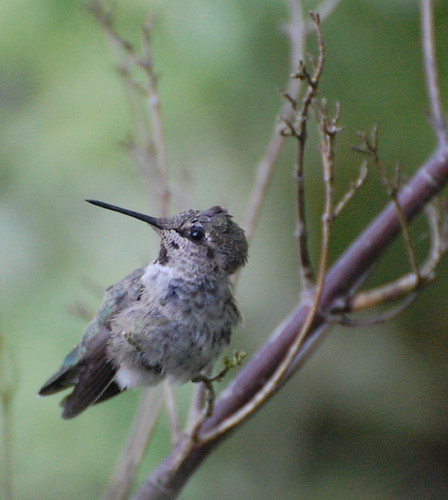Gardening in my little corner of the Pacific Northwest is a challenge. Actually, I don’t know whether my soil problems are local, or simply peculiar to my property. I couldn’t say what kind of soil naturally occurs in this area, because my house is built on layer upon layer of what they call "fill." Apparently, our lot is situated in a low spot in the development, and the builders contrived to solve "drainage problems" (which means we are living on what was once largely a swamp) by dumping truckloads of whatever was handy and then running a cat(erpillar—BIG-ass tank-like monster) over and over it until it was tamped down harder than the most impervious concrete.
Most developers will then condescend to throw topsoil over the mess so that the homeowners can at least grow a lawn. It’s possible that whoever built our home made some token gesture in that direction…but not nearly enough. To be healthy, grass roots need to be able to go down at least a foot. The two or three inches of barely arable soil sprinkled atop our "fill" make it a challenge to even grow decent-looking grass, much less anything else. Planting anything with a root system deeper that two inches entails employing a tool that I never envisioned would be an essential part of my garden arsenal—a pick-axe. The first time we planted a tree, it took us four hours to carve out a hole to put it in.
The best thing for this property would have been to dump three or four feet of topsoil over the whole thing and start over. If only such remedies came cheap! There was no way we could afford to do that when we first moved in. In fact, there’s no way we could afford to do it now, five years later. So I’ve spent the last five years scratching up the top few inches of this intractable crap we’re living on, mixing in as much compost as I can afford, and taking my chances
I want an awesome garden, but I don’t want to make a career out of creating or maintaining it. Up until now, we’ve been lucky enough to own properties where you could just plop things in the ground and watch them grow. Not so with the moon-soil on this lot. I’ve watched perennials, bushes, trees, even annuals wither and expire within weeks of touching their toes to this toxic, rocklike mess. And even the plants that eventually do make it languish on the edge of death for at least a year before they finally take hold. Since I am anything but a patient gardener, this waiting game/death dance drives me crazy. At least, in the five years I’ve been fighting this battle, I have discovered a few plant species that, in spite of all the odds stacked against them, will thrive in my gardens. At least now I know what I can plug into an empty spot and expect to grow.
The last few years, May has been my month for intensive garden work. With a business that eats up most of my summer weekends, whatever yard fixing needs to be done, had better be done in May, or it will have to keep until November. Or next May. So yesterday, under gray skies that occasionally spit a few drops of rain on my efforts, I literally dug in to my languishing shrub border. This one has been a challenge. Besides the crap-shoot of getting anything to grow, I have not had much success designing this bed. It has looked flat, hodge-podgy and scraggly from day one. I’ve re-arranged, uprooted, re-planted, and fussed, and nothing seems to make it look any better.
Part of the problem has been my soft-hearted reticence to pull the plug on any plant until it is completely, utterly, and irretrievably dead. No matter how stunted, misshapen or obviously not thriving a plant is, if it is brave enough to send out a green shoot or two in the spring, I let it be. This has resulted in four rosebushes planted by the previous owners taking up valuable space front and center of my shrub border. I warned these bushes when we moved in that they would be allowed to stay only if they could tolerate the same treatment as any other plant in my world: a month of fussing, followed by eleven months of benign neglect. Up until this spring, they have bravely soldiered on, sending out flowers beautiful enough to compensate for the rest of their increasingly shabby-looking selves. But when I went out to inspect them yesterday, it was obvious that our month of below-freezing weather this past winter had finally pushed them past the point of no return. Still, it broke my heart to cut them down and dig them out, the last few puny buds they’d been able to squeeze out trembling at the ends of the black-spotted stems.
So, yesterday I dug out three of those rose bushes, dug up and replanted two buddleias (butterfly bushes), hacked holes in the ground to sink a couple of new escallonias, planted some daylilies that I dug up from the front yard two years ago and have been living in shallow pots ever since, and battled my bucking Mantis tiller as I tried vainly to break up the soil and mix in enough compost to give the poor plants a fighting chance. I didn’t realize how hard I had worked until I tried to get out of bed this morning. I felt like I had been tied by my ankles and dragged behind a truck for a few hundred yards. Not to mention the sinus issues caused by the clouds of yellow pollen that poufed out of my little mugo pines every time I rubbed against them. Ah-choo!
I was all ready to shoulder the shovel and sally forth again this morning. But the skies were gray, and it has been pouring rain on and off all day. I guess the Powers That Be took stock of my age, condition, and the job ahead of me, and decided I needed a day to recuperate. There are 24 days left in the month, so there’s no big rush. Tomorrow is soon enough to take another crack at it.



















Occasionally you see those articles about no fuss gardening. Yeah, right!!
ReplyDeleteWe have soil that's rock hard too. I've had good luck sustaining life in anything "native". So...that's the route to go.
However...ALL the weeds are native. And with soil like concrete...they're almost immortal. I think you have to have a crazy gene to get into this.
I hope you feel better tomorrow. Unfortunately, the second day after is often worse than the first. Maybe you'll get a little more rain.
:)
Yours is man made hard pan ours is clay. Trying to plant anything requires patience, a fair amount of water and plenty of compost. Doing ok for now.
ReplyDeleteJackie
Good luck, if I had to fight the very soil, I know I'd never even dream of gardening.
ReplyDelete"Part of the problem has been my soft-hearted reticence to pull the plug on any plant until it is completely, utterly, and irretrievably dead. No matter how stunted, misshapen or obviously not thriving a plant is, if it is brave enough to send out a green shoot or two in the spring, I let it be."
ReplyDeleteI even have this problem with weeds. There are almost as many weeds as anything else especially in the spring.